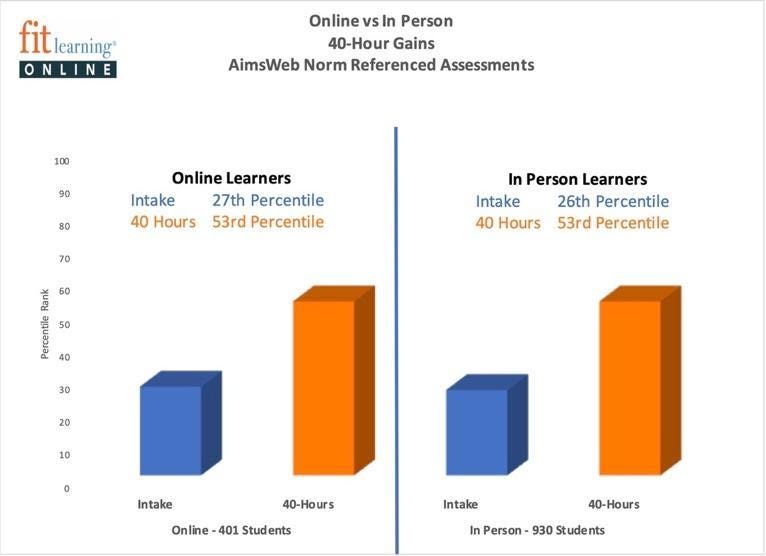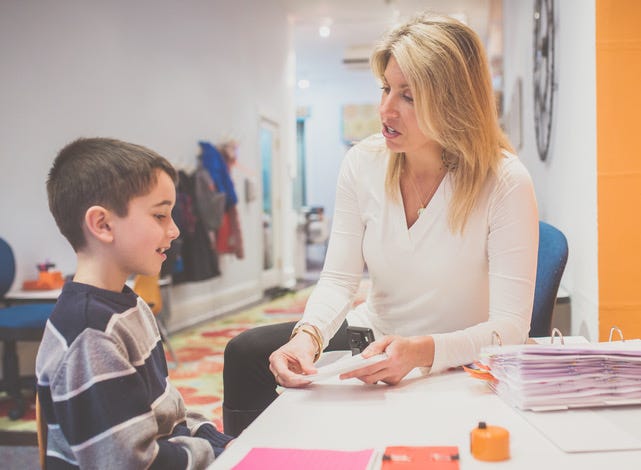Education Revolution: Kimberly Nix Berens Of Fit Learning Online On Innovative Approaches That Are Transforming Education
An interview with Eden Gold
1 . It’s a marathon, not a sprint.
2 . Trust the science, even when others don’t.
3 . There’s never enough time but make time for yourself anyway.
4 . Enjoy the process.
5 . Make friends with fear.
The landscape of education is undergoing a profound transformation, propelled by technological advancements, pedagogical innovations, and a deepened understanding of learning diversities. Traditional classrooms are evolving, and new modes of teaching and learning are emerging to better prepare students for the complexities of the modern world. This series will take a look at the groundbreaking work being done across the globe to redefine education. As a part of this interview series, we had the pleasure to interview Kimberly Nix Berens.
Kimberly Nix Berens, Ph.D., is the Founder of Fit Learning and CEO of Fit Learning Online. She co-created a powerful system of instruction based in behavior science and the Technology of Teaching, which has transformed the learning abilities of thousands of children worldwide. For more than 20 years, her system of instruction has produced at least one year’s worth of academic growth in only 40 hours of training. Her learning programs effectively target such essential areas as early learning skills, basic classroom readiness, phonemic awareness, reading fluency, comprehension, inferential language, basic and advanced mathematics, logical problem solving, grammar, and expressive writing. From her early beginnings in a broom closet at the University of Nevada — Reno, Dr. Berens has helped grow Fit Learning to an organization with centers located throughout the US, Canada, Europe, and Australia. In her current role as CEO of Fit Learning Online, she focuses on increasing access for learners living in regions without a Fit Learning center. Dr. Berens is a frequent invited speaker and a contributor to many popular press publications such as Thrive Global, 74 Million, and Medium. Her first book, Blind Spots: Why Students Fail and the Science That Can Save Them, was released in October of 2020.
Thank you so much for doing this with us! Our readers would love to “get to know you” a bit better. Can you share the “backstory” behind what brought you to this particular career path?
I discovered behavior science through my undergraduate mentor, Dr. Maria Ruiz where I learned that human learning follows a lawful process, which was discovered through natural science and enables the prediction and influence of learning in ways that dramatically improve quality of life. As an undergraduate, I gained applied experience working with adults and children with developmental disabilities and was eventually recruited into the doctoral program in behavior science at the University of Nevada-Reno where I initially continued my work in autism. As a graduate student, I became increasingly dismayed at the narrow impact our field was making. Although behavior science was widely known to be the most effective treatment for children with autism, it was relatively unheard of in mainstream education. I couldn’t understand why the science of learning wasn’t being used to guide teacher training or the design of classroom instruction. So, in 1998, I decided to start an after-school tutoring program on campus as a means of developing an instructional approach for mainstream learners based on behavior science. By 2002, the success of that program led me to open my first Fit Learning location. We now have 22 Fit Learning locations worldwide in addition to a model for teacher training and school implementation. I also recently launched Fit Learning Online to increase access for as many learners as possible.
Can you share the most interesting story that happened to you since you started your career? Can you tell us what lesson you learned from that?
A LOT has happened in my 30-year career, but the COVID-19 pandemic wins for the “most interesting” story. Although we had been conducting some online sessions since 2013, most of our learners attended live sessions at our physical locations. However, the arrival of COVID-19 in 2020 forced us to temporarily close our physical locations and scale an organization-wide online model of instruction. The results of that initiative astounded us. We discovered that we produce the same remarkable gains with our online learners as we do with our learners who attend in-person sessions. I recently launched Fit Learning Online as a means of increasing access to my transformative approach for as many learners as possible. No longer limited by geography, we can now dramatically accelerate essential academic skills with learners regardless of where they live. From the COVID experience, I learned that you must continually take risks and pivot, which led me to discover the power of our online model and launch Fit Learning Online. We now have the potential to change the lives of many more learners. I feel very proud and grateful that we created something remarkable from such a tragic situation.
Can you briefly share with our readers why you are an authority in the education field?
I have a Ph.D. in behavior science and have been developing a system of instruction based on that science since 1998. I combine Precision Teaching, Direct Instruction, and Curriculum-Based Measurement into a comprehensive approach that has dramatically accelerated the academic skills of thousands of learners. My approach consistently produces an average gain of 27 percentile ranks on norm-referenced academic assessments in only 40 hours of instruction, which reflects more growth than most students make in an entire school year. We produce these same remarkable gains regardless of whether a learner is enrolled online or attends in-person sessions (see outcome graph below).

Can you identify some areas of the US education system that are going really great?
The recent shift in awareness regarding the importance of phonics for reading instruction reflects a very promising trend. The national attention garnered by the Science of Reading will not only increase the likelihood that more kids achieve proficient reading skills but may also lead to the science of learning guiding instructional practices. It’s an exciting time for educators!
Can you identify the key areas of the US education system that should be prioritized for improvement? Can you explain why those are so critical?
Since the 1960s, instruction guided by behavior science has produced exponentially greater learning gains than traditional approaches. Sadly, this science continues to be ignored or erroneously refuted by the educational establishment. Until teaching practices are designed according to the science behind the learning process, education will never improve. Behavior science indicates that learning occurs, and only occurs, through the repeated, reinforcement of behavior over time. Moreover, complex academic repertoires must be broken down into essential component skills, and these component skills must be repeatedly practiced until fluency is achieved. Fluency is a measure of mastery in behavior science that entails both accuracy and speed. Fluency produces neurological permanence of skills, resistance to distractions and fatigue, and the ability to effortlessly learn and master more complex skills. Our current educational system emphasizes exposing students to lots of content and pushing them ahead to new content regardless of skill mastery. As a result of that practice, close to 70% of US students graduate below proficiency in all academic areas. Moreover, students become less proficient the longer they spend in our school system. Proficiency rates decline across the grade levels because students are continually pushed ahead to the next grade level without the prerequisite skill mastery required to successfully learn at that higher level. School reform must focus on producing fluency in prerequisite academic skills during the primary grades such that middle and high school students have the necessary foundation to master higher-level skills.
Please tell us all about the innovative educational approaches that you are using. What is the specific problem that you aim to solve, and how have you addressed it?
My method combines Precision Teaching (PT), Direct Instruction (DI), and Curriculum-Based Measurement (CBM). Each approach was heavily influenced by behavior science and has decades of evidence regarding its effectiveness.
Precision Teaching (PT) is a system of measuring and analyzing learning such that immediate, effective instructional decisions can be made. In PT, learners perform skills during timed practice periods such that rate of response (i.e., count per minute) can be measured. Rate of response is the fundamental measure of behavior and celeration is the fundamental measure of learning. Rates of response during daily practice are graphed across days and lines of best fit through these data points yield a celeration — a quantifiable index of learning that allows educators to make important predictions about learning. PT allows teachers to function as scientists in their work as educators.
Direct Instruction (DI) is an instructional approach that ensures efficient and effective concept learning. Through the construction of faultless communications, teachers rapidly present concepts to learners and ask flexible questions that target examples and non-examples of the concept to facilitate generalization and mastery. DI also requires active, choral responding by the entire class so that every student remains engaged, responds to the lesson, and receives feedback from the teacher.
Curriculum-Based Measurement (CBM) is a progress monitoring method that enables educators to conduct frequent, short assessments with their students at weekly, monthly, or quarterly benchmarks throughout the school year to evaluate student progress toward grade-level goals. Frequent progress monitoring of this sort provides valuable and timely information about student progress that educators can use to make important decisions about classroom instruction.
In what ways do you think your approach might shape the future of education? What evidence supports this?
The most significant advances have been achieved through science. Remarkable achievements in medicine, engineering and agriculture have dramatically improved our quality of life. These same kinds of advances are possible in education if science becomes the guiding framework from which educators design instruction. A science of learning exists, which has led to a profound understanding of how to produce the most rapid and robust learning gains. Large-scale studies evaluating the effectiveness of Precision Teaching, Direct Instruction, and Curriculum-Based Measurement all indicate that when behavior science guides instructional practices, exponentially greater learning outcomes are produced. If these approaches were adopted by US schools, students would acquire fluency in essential academic skills and graduate at the advanced level in all academic subjects.
How do you measure the impact of your innovative educational practices on students’ learning and well-being?
At Fit Learning, we measure every skill our learners perform as rate and celeration. From these measures, we make important decisions about instruction such as whether a skill has been mastered or requires an intervention. We also conduct weekly CBM assessments to monitor our learners’ progress towards grade-level standards as they are practicing component skills to fluency. Finally, we collect behavioral measures related to self-confidence during sessions such as positive and negative statements made, instances of compliance and noncompliance, personal best goals achieved, and programs mastered.
What challenges have you faced in implementing your educational innovations, and how have you overcome them?
By far my biggest challenge has been convincing members of the educational establishment about the power of behavior science for the design of instruction. The traditions, myths, and beliefs that influence educators pose significant barriers to their adopting science-based approaches. Sadly, I can’t say that I have overcome this challenge, but I have succeeded in creating shifts for many traditional educators. My book Blind Spots: Why Students Fail and the Science that Can Save Them has helped move the needle as well as my podcast interviews and media appearances. I always say that my work is a marathon, not a sprint.
Keeping in mind the “Law of Unintended Consequences” can you see any potential drawbacks of this innovation that people should think more deeply about?
The only drawback of implementing instruction guided by behavior science would be inadequate training and oversight. Teachers require effective training and ongoing supervision to master this repertoire, which requires resources, funding, and administrative support. However, we have designed a model for teacher training and school implementation that has produced significant results in several pilot studies. With proper administrative support, we have demonstrated that schools can successfully launch these efforts and dramatically increase the proficiency rates of their students.

What are your “5 Things I Wish I Knew When I First Started”?
1 . It’s a marathon, not a sprint.
2 . Trust the science, even when others don’t.
3 . There’s never enough time but make time for yourself anyway.
4 . Enjoy the process.
5 . Make friends with fear.
Can you please give us your favorite “Life Lesson Quote”? Can you share how that was relevant to you in your life?
Focus on the personal best. This advice applies to every learner I work with at Fit Learning, everyone I mentor, my children, and myself. As a culture, we are trained from an early age to focus on competing with others, which is a very toxic and disempowering mindset. We should focus on achieving our own personal best. By making small but consistent incremental improvements in our performance, we can all achieve amazing things!
We are blessed that some of the biggest names in Business, VC funding, Sports, and Entertainment read this column. Is there a person in the world, or in the US, with whom you would love to have a private breakfast or lunch, and why? He or she might just see this if we tag them 🙂
I would love to share a meal with Dr. Anita Archer. She originally trained me in Direct Instruction during a workshop in the 1990s. In my opinion, Dr. Archer is the most remarkable and transformative classroom teacher on the planet. You can access videos of her teaching on YouTube.
How can our readers further follow your work online?
www.drkimberlyberens.com; www.fitlearningonline.com; www.fitlearning.com
Thank you so much for these insights! This was so inspiring!
About The Interviewer: Eden Gold, is a youth speaker, keynote speaker, founder of the online program Life After High School, and host of the Real Life Adulting Podcast. Being America’s rising force for positive change, Eden is a catalyst for change in shaping the future of education. With a lifelong mission of impacting the lives of 1 billion young adults, Eden serves as a practical guide, aiding young adults in honing their self-confidence, challenging societal conventions, and crafting a strategic roadmap towards the fulfilling lives they envision.
Do you need a dynamic speaker, or want to learn more about Eden’s programs? Click here: https://bit.ly/EdenGold
Education Revolution: Kimberly Nix Berens Of Fit Learning Online On Innovative Approaches That Are… was originally published in Authority Magazine on Medium, where people are continuing the conversation by highlighting and responding to this story.


